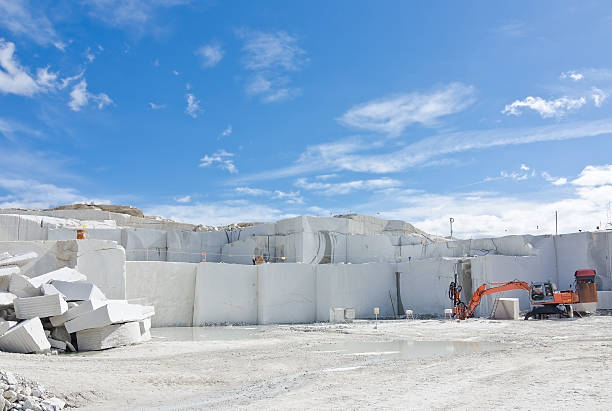Uncovering the Appeal of Granite Quarry in South Africa Wonders
Uncovering the Appeal of Granite Quarry in South Africa Wonders
Blog Article
Introducing the Mysteries of Granite Quarrying: Where Strength and Sophistication Meet
The globe of granite quarrying is a realm where the raw strength of nature assembles with human virtuosity to develop structures that stand the test of time with an air of elegance. From the midsts of quarries to the meticulous polishing in workshops, the procedure of changing granite right into architectural wonders is a complex dancing of practice and innovation. As we peer right into the midsts of this old craft, we begin to reveal the concealed complexities that shape the very significance of our developed setting.
The Origins of Granite Quarrying
In the record of building background, the origins of granite quarrying are shrouded in a tapestry of old craftsmanship and geological marvels. Dating back to old Egypt and Mesopotamia, the removal of granite from quarries marked the beginning of a trip that would ultimately bring about the development of a few of the world's most legendary frameworks.
Granite quarrying's roots can be mapped to the knowledgeable craftsmens who acknowledged the rock's toughness and aesthetic charm. With a combination of primitive devices and large resolution, these early quarry employees uncovered granite blocks that would come to be the foundation of people.
As worlds advanced, so did the methods of quarrying granite. The Romans, renowned for their design prowess, established sophisticated techniques for removing granite to build monoliths, temples, and roads that stood the examination of time.
The heritage of these old quarrying practices continues to shape modern-day design, with granite remaining a symbol of toughness and beauty in building projects around the world. (granite quarries in south africa)
Devices of the Quarrying Trade
The advancement of granite quarrying methods from old civilizations to modern-day times highlights the crucial role played by the devices of the quarrying sell forming the industry's practices. In old times, quarrying devices were rudimentary, frequently being composed of knives, hammers, and wedges made from products like bronze or iron. These tools called for considerable manpower and time to essence granite blocks from quarries.

Furthermore, the introduction of pneumatically-driven devices and high-powered equipment has actually substantially reduced the physical labor called for in quarrying procedures, enhancing employee security and performance. As the quarrying sector remains to innovate, the tools of the profession continue to be at the center of driving development and shaping the future of granite removal.
Drawing Out Blocks of Granite
Using precision equipment and progressed methods, the extraction of granite blocks from quarries has actually become an innovative process in the modern quarrying sector. Controlled blasting techniques are after that employed to break apart the granite into workable sections.

Sprucing Up and Finishing Methods
To achieve a perfect surface on granite blocks, competent artisans use a collection of meticulous sprucing up and finishing strategies. After the preliminary removal and shaping processes, the granite blocks go through a comprehensive polishing phase to enhance their natural beauty and longevity. One typical technique used in my review here brightening granite is ruby abrasion, where industrial rubies are utilized to grind and polish the rock to a smooth surface. This procedure not only produces a shiny surface area however also ensures uniformity in shade and appearance throughout the granite block.
Along with sprucing up, finishing methods are put on further refine the granite's appearance. These methods might consist of flaming, honing, or brushing, each offering special appearances and coatings to suit different aesthetic preferences. Flaming, for example, entails revealing the granite surface area to high temperatures to create a rough, textured finish, suitable for outside applications where slip-resistance is necessary. Sharpening, on the various other hand, provides a matte finish that is smooth to the touch, perfect for indoor countertops and flooring. By thoroughly choosing and applying these polishing and finishing techniques, artisans can change raw granite blocks into exquisite pieces that display both toughness and style.

Ecological Impact and Sustainability
With the expanding emphasis on ecological awareness in the industry, granite quarrying techniques are increasingly looked at for their influence on natural deposits and long-lasting sustainability. Quarrying for granite can have substantial environmental ramifications. The removal process commonly involves using hefty machinery, dynamites, and huge quantities of water, resulting great site in environment devastation, soil erosion, and water contamination. In addition, the transportation of granite from quarries to processing centers creates carbon emissions, even more adding to ecological destruction. granite quarries in south africa.
To minimize these impacts and ensure sustainability in granite quarrying, industry stakeholders are embracing various steps. Implementing sophisticated innovations to minimize power usage and water usage, recovering quarried land for eco-friendly remediation, and promoting accountable sourcing methods are some techniques being employed. Certifications such as the Woodland Stewardship Council (FSC) and the Management in Energy and Environmental Design (LEED) help customers determine eco friendly granite items.
Final Thought
In conclusion, granite quarrying is a procedure that needs specialized devices and methods to extract blocks of granite and brighten them to a high level of coating. While the environmental influence of quarrying can be considerable, efforts are being made to enhance sustainability practices in the market. Overall, granite quarrying is a fragile balance in between utilizing the toughness and sophistication of this all-natural stone while decreasing its influence on more the setting.
Report this page